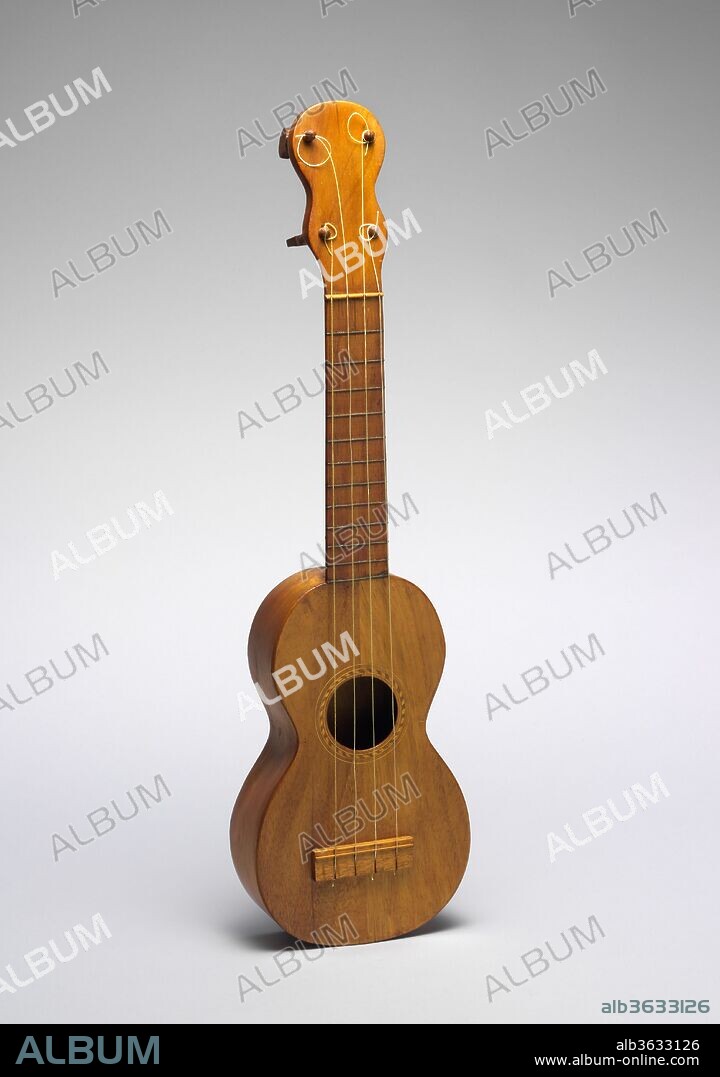alb3633126
UKULELE

|
Add to another lightbox |
|
Add to another lightbox |



Buy this image.
Select the use:

Title:
UKULELE
Caption:
Ukulele. Culture: Polynesian (Hawaii). Dimensions: Height: 20 1/2 in. (52.1 cm)
Width: 5 1/2 in. (14 cm). Date: ca. 1880.
The most familiar Hawaiian instrument is the 'ukulele, a small type of guitar. The instrument was probably introduced to Hawai'i in 1879 by Portuguese settlers from Madeira who brought with them a small guitar called the braguinha. The settlers included three men, Manuel Nunes, Augusto Dias, and Jose do Espirito Santo who knew how to make braguinha. The small guitar quickly became popular with Hawaiians and by 1888 Nunes, Dias, and Espirito Santo were all producing examples for the local market. The instrument was modified to suit local musical tastes and the Hawaiian 'ukulele was born. Probably from the late 19th century, this work is among the oldest known 'ukulele.
The 'ukulele found favor in the court of the Hawaiian King David Kal?kaua, a champion both of customary Hawaiian music and musical innovation. Under Kal?kaua's patronage, the 'ukulele was adapted to accompany hula dance performances, transforming the more sedate tempo of earlier types of hula into the more lively rhythm characteristic of many hula performances today.
There are several accounts of how the 'ukulele got its name, which means "jumping flea." Edward Purvis, a small, lively musician popular in Kal?kaua's court was reportedly nicknamed " 'uku lele" and the instrument may be named after him. Alternatively, the rapid action of the musician's figures when playing possibly reminded Hawaiians of jumping fleas. The name may also represent a modified version of 'ukeke, the term for the mouth bow, previously the only string instrument in Hawai'i.
Technique/material:
Mahogany, hardwood, metal
Museum:
Metropolitan Museum of Art, New York, USA
Credit:
Album / Metropolitan Museum of Art, NY
Releases:
Image size:
3093 x 4400 px | 38.9 MB
Print size:
26.2 x 37.3 cm | 10.3 x 14.7 in (300 dpi)
Keywords:
CHORDOPHONE-LUTE-PLUCKED-FRETTED • CHORDOPHONES • GUITARS • HAWAII • HAWAII, UNITED STATES • LUTES • MAHOGANY • MAHOGANY, HARDWOOD, METAL • METAL • METROPOLITAN MUSEUM OF ART, NEW YORK, USA • MUSIC INSTRUMENTS • MUSICAL INSTRUMENTS • MUSICAL_INSTRUMENTS • NORTH AND CENTRAL AMERICA • UKULELES • UNITED STATES • WOOD
 Pinterest
Pinterest Twitter
Twitter Facebook
Facebook Copy link
Copy link Email
Email
